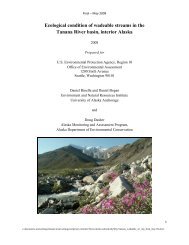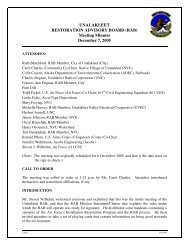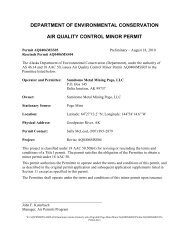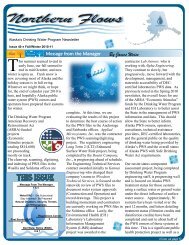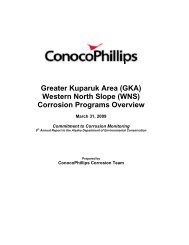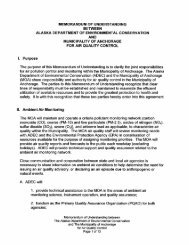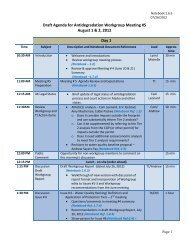2012 Ocean Ranger Guidebook Revision 3-7-12 - Alaska ...
2012 Ocean Ranger Guidebook Revision 3-7-12 - Alaska ...
2012 Ocean Ranger Guidebook Revision 3-7-12 - Alaska ...
You also want an ePaper? Increase the reach of your titles
YUMPU automatically turns print PDFs into web optimized ePapers that Google loves.
<strong>20<strong>12</strong></strong> <strong>Ocean</strong> <strong>Ranger</strong> <strong>Guidebook</strong> 3-7-<strong>12</strong><br />
determine whether a discharge is probable include, but are not limited to— (1) Ship location and proximity to land<br />
or other navigational hazards; (2) Weather; (3) Tide current; (4) Sea state; (5) Traffic density; (6) The nature of<br />
damage to the vessel; and<br />
(7) Failure or breakdown aboard the vessel, its machinery, or equipment.<br />
Subsection 2: Safety, General<br />
Job Aid Item: 5.2.a<br />
Text: Safety protection procedures of cleaning chemicals are conducted IAW Material Safety Data<br />
Sheet (MSDS).<br />
Background: Material safety data sheets or products safety datasheets should be supplied with all<br />
potentially hazardous or toxic chemicals. These sheets are intended to inform the end user of hazards,<br />
physical data, and how to safely handle and use the product. They should also identify the use and need<br />
of personal protection gear.<br />
What to check for: Check that MSDS (if available) recommendations are being followed with regard to<br />
safety, storage, and disposal requirements to protect passengers and crew. There can be flag state<br />
differences in the name and style of safety information. The Safety Management System (SMS) should<br />
include information on what is required and how to find the safety information.<br />
MSDS or similar sheets can be a useful way to determine if a substance is toxic and/or hazardous<br />
when checking items in Section 3 and must be included (if available) in waste offload plans if<br />
hazardous waste is offloaded in <strong>Alaska</strong>.<br />
Citation:<br />
18 AAC 69.040. Hazardous waste and hazardous substance offloading plan. (Excerpt)<br />
(a) As part of the plan required under AS 46.03.475(e)(2), that describes a vessel's policies and procedures for<br />
offloading of hazardous waste or a hazardous substance from a vessel while that vessel is operating in the marine<br />
waters of the state, and to the extent that the offloading is not covered by a report or notice submitted under AS<br />
46.03.475(d), the owner or operator shall include, for each vessel that the owner or operator intends to operate,<br />
or cause or allow to operate, and for each hazardous waste or hazardous substance anticipated to be offloaded,<br />
(3) material safety information provided by the manufacturer, if applicable;<br />
33 CFR 96.230 What objectives must a safety management system meet?<br />
The safety management system must:(a) Provide for safe practices in vessel operation and a safe work<br />
environment onboard the type of vessel the system is developed for;(b) Establish and implement<br />
safeguards against all identified risks;(c) Establish and implement actions to continuously improve safety<br />
management skills of personnel ashore and aboard vessels, including preparation for emergencies<br />
related to both safety and environmental protection; and(d) Ensure compliance with mandatory rules and<br />
regulations, taking into account relevant national and international regulations, standards, codes and<br />
maritime industry guidelines, when developing procedures and policies for the safety management<br />
system.<br />
33 CFR 96.310 Who does this subpart apply to?<br />
This subpart applies:(a) If you are a responsible person who owns a vessel(s) registered in the U.S. and engaged on<br />
a foreign voyage(s), or holds certificates or endorsement of such voyages;(b) If you are a responsible person who<br />
owns a vessel(s) registered in the U.S. and volunteer to meet the standards of this part and Chapter IX of SOLAS;(c)<br />
To all foreign vessels engaged on a foreign voyage, bound for ports or places under the jurisdiction of the U.S., and<br />
subject to Chapter IX of SOLAS; or(d) If you are a recognized organization authorized by the U.S. to complete safety<br />
management audits and certification required by this part.<br />
33 CFR 96.370 What are the requirements for vessels of countries not party to Chapter IX of SOLAS?<br />
175






